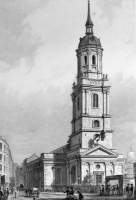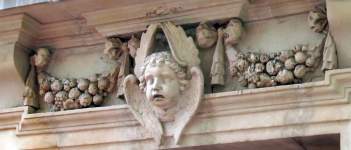 .
.
St Magnus the Martyr, a Wren Church in Thames Street, just down Fish Street Hill from the Monument in the City of London, has a good crop of monuments and a lively, almost gaudy interior with a certain exotic ambience, and should rank fairly high on the list of City Churches to visit.
The pre-Fire church was reputed for its rich monuments, alas lost. Yet in John Stow’s time around 1600, he found them ‘now for the most part utterly defaced’, though he did find ‘Henry Yeuele, Freemason to Edward III, Richard II and Henry IC, who deceased 1400; his Monument yet remayneth.’ Among others he lists several mayors, 'Richard Morgan Knight, chiefe Justice of the common please' d.1556, Mauritius Griffeth, Bishop of Rochester, d.1559, Robert Harding, Salter, 'one of the Shirriffs', 1568, and ‘Sir William Garrard, Haberdasher, Mayor 1555, a grave, sober, wise and discreete Cittizen, equall with the best, and inferior to none of our time, deceased 1571.’ Also buried there, under a monument of his own construction, was Henry Yevele, d.1400, mason to Edward III, Richard II and Henry IV, who made the monument to QUeen Anne of Bohemia in Westminster Abbey. The Great Fire of London swept all away.
Christopher Wren built the current edifice in 1671-6/7. The tower and steeple, rather large for the body of the church, are considered among Wren’s best, and dates a little later, being put up in the 1700s. The site of the church was just by Old London Bridge, and this explains the open porch under the tower, which was constructed, or rather reconstructed, so that those wishing to walk across the bridge could conveniently follow this direct path from the street. The new London Bridge, as typical, was built a little way along the river from the old one. From the street we see the flat wall of aisle and the top of the nave, the former with round windows on blank panels, the latter with oval windows. It seems that the aisle windows were once larger and more conventional, but reduced on the north (street side) so as to cut traffic noise – those on the south side remain full size. Above each round window is a shelf on brackets, and a cherubic head in the key stone position; a side door to the street also has a round window above, with a fructifying festoon above it. The stone mason for St Magnus was John Thompson, who worked for Wren on a number of City Churches, and presumably it was he who was responsible for the carving of the capitals and the scrolls.
The position of the church today is not the happiest, with the large buildings and the fast road. However the grand tower and steeple, 185ft to the top, remains impressive. The tower is square in cross section, recessing slightly at each level, with a balustrade with pots around an upper octagonal construction, which has Corinthian pilasters along each edge, all surmounted by a lead dome and little spire. The view from Fish Street Hill shows the tower against the end of the street, and despite concrete and glass behind and to the right, is perhaps the best aspect of the tower. A large clock is mounted above the porch on a bracket, which dates from 1709, shortly after the tower was completed, the donor being Sir Charles Duncombe, Lord Mayor, goldsmith and banker.
There is further minor decoration around the porch, including rich carving of roses and other fruits and leaves around the pillar tops. In the little yard stand a few pieces of stonework, unlabelled, which I understand to be blocks taken from Old London Bridge when it was demolished, which would make them 12th Century.
Inside, the shape of the church is an open hall consisting of a nave and two aisles, with slim ionic columns to mark the division but not really separate the space. The impression is of sumptiousness – a fullness with dark pews, shrine-like constructions with statues and paintings, a wall of small monuments to the north, and fewer but more ornate ones to the south or river-side. The post-war glass in the large southerly windows, showing St Magnus, St Thomas, St Michael, and St Margaret, with various buildings, monks, angels and dragons, is excellent, particularly St Margaret, in bronze toned garments and with finely depicted face and hands. That in the little windows to the north side include a weird mermaid and armoured merman and winged dolphins, and date from 1959.
Much of the exotic atmosphere arises from a 1920s restoration by Martin Travers, and it was during this time that the colourful statue of St Magnus, complete with horned helmet and axe, was added.
We may also note the large altar piece, with Moses and Aaron paintings, and carved décor, including crucifixion, two adjacent figures of saints, and two angels seated in subsidiary positions on left and right flanks; and the highly carved pulpit and sounding board. The carved marble font has a boxlike wooden cover and is suspended from a gilt dove. All this dating from the earliest days of the church.
And the monuments:
Other, more modest 18th Century plaques include W. Hassell, d.1737; William Williams, d.1764 and wife Blanch, d.1784 and daughters; Joseph Williams, d.1778, wife Elizabeth, d.1814, and various relatives (despite the date, this is a 19th C monument by Thomas Piper III apparently).
Between the large windows on the right hand (southern) aisle are two tall monuments from the end of the century:
Carrying on in the 19th Century, we may note the following:
We may note without description the monuments to Jane Bouch, d.1820, and husband John Bouch of Monument Yard, d.1830; Sarah Huxley, d.1818, and parents Ann and Joseph Eaton, both d.1821; Richard Dendy of Monument Yard, d.1822, and wife Elizabeth, d.1828, and daughter; Nathaniel Saunders, d.1830; John King, d.1835, and wife Mrs Lydia Bailey King, d.1850, and two daughters; Jonas Waters, d.1837; Henry Fenn, and wife Jane, d.1840; Revd Alexander McCaul, d.1863; Revd Alexander Israel McCaul, rector, d.1899.
 Cherubic head, perhaps by John Thompson, Wren's mason for this church.
Cherubic head, perhaps by John Thompson, Wren's mason for this church.
East and North to St Mary at Hill // or a bit further to St Dunstan in the East (ruin) // north and up King William St to St Mary Woolnoth
City Churches // Christopher Wren // London sculpture // Sculptors // Introduction to church monuments
Angel statues // Cherub sculpture
Visits to this page from 26 Feb 2012: 10,475